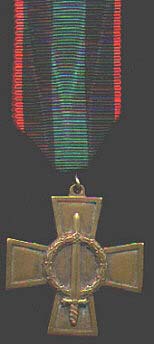
 |
Taipale gallery, year 1939-1940
Taipale gallery, year 2000-2001Introduction: A few words about the matter and author.
My name is Kirill and I live in St. Petersbug, Russia. I'm interested in the history of two Soviet-Finnish wars ("Winter" and "Continuation"), especially actions on Karelian Isthmus for few years. There are a few books on Russian and English describing this wars (English books could be listed by means of net search engines). However, even those books has the overall view of the "Winter war" (though some of them has some kind of detail description per sectors. The most detailed description of Taipale battles are on Finnish, but this language as hard to learn as Russian, so 90 % of that precious information (for ones who interested of) is covered. From the opponent side, Russian information sourses are negligible. There are no Taipale veterans' memoires: first, because of discreditable actions of Russian troops and second, because the actual combatants were killed in action (no matter that war: "Winter" or "Continuation") or dead because of old age. As for former Soviet official information sources (war and history archives), the information about four Soviet divisions involved in the battles on Taipale is secret for nowadays. I'm trying to describe the chronology of "Winter war" on Taipale. And the last: sorry for possible grammatic errors - on Russian it would be better... For all your comments or anything like that please e-mail me.Taipaleenjoki (now "Burnaya") is small river flowing from lake Suvantojarvi (now Suhodolskoje) to lake Ladoga, situated in the North-East part of Karelian Isthmus. Before the war, there were four tiny finnish villages: Kirvesmaki, Koukkuniemi, Terenttila and Taipale itself (see Finnish map). Erection of military fortifications in this sector was started as early as 20's but unlike the fortifications in such sectors as Summa or Koivisto (North-West part of Isthmus) it was not so strong. The main profit of this position was the river itself, with the abrupt banks and open space over there.
There were ten concrete bunkers on the whole region (see map). Basically they were the small thin-walled machine gun bunkers erected on the most critical points: river elbows, some salienses and ledges. Despite its poor withstanding of modern (even for that time) artillery fire, they were perfect prepeared as well as they had pre-fired sectors of open land in front of. Finnish army expected Soviet invasion for dozen and half years...
 |
| Field of the former Terenttila village, winter-2000. View from "school wood" (Kansakoula metsikko) to Mustaoja (Trees' wall at the far rear). In the left side is Taipaleenjoki river. (Photo: K.Jakimovich) |
The main defence line (called "Mannerheim line" during the war) was laid not only upon Taipaleenjoki but through the wooden part of Taipale penninsula, between east end of the river and east shore of lake Suvantojarvi. The line consisted of trenches, barbed wire obstacles and machine gun stone and log positions. There were no anti-tank obstacles but some small stones' chains and wooden log's abatis plus anti-tank ditches. Trenches were dug in upon the edge of woods and ridges.
The very important role of Taipale's defense played two coastal batteries - first, "Kaarnajoki", called that because of tiny river near the position, and second, "Jariseva", situated right on the shore of lake Ladoga. The main task of "Jariseva" battery was the defense of coast and left flank of Taipale sector while "Kaarnajoki" would cover under fire the whole Taipale sector at 360 degrees (the fire radius of this battery was almost 20 km). The battery has four gun positions with 152 mm guns. Western flank of Taipale sector was defended by gun bunkers erected on shore of lake Suvanto near village Kelja and Patoniemi. This bunker has three gun as well as few mashine gun and would cover under fire the whole open space of lake Suvanto. Also, there were few logged mashine gun positions alongside lake Suvanto shore as well as lake Ladoga shore.
The fortifications of this region were unique - not because of those strenghtness but of those closest position to the Soviet-Finnish border. All constructing works made between 20-30's were made under cover of top secret. There were no any serious "delay positions" between main defence line and state border as it would be in the South-Western part of Karelian Isthmus. The first defense line would became the last line - there were no another decision. The Taipale position has its own trap for expected invader: no-mans-land from the southest elbows of river Taipaleenjoki to the Kirvesmaki defense trenches. It was Koukkuniemi penninsula, low and marshy mostly open land pre-fired by mashine guns and Kaarnajoki battery. It was the one and only comparatively comfortable place to get across river, to group and to start attack. Finnish HQ waiting for this maneuvre of enemy.. In the future, events became as it were expected by Finns.
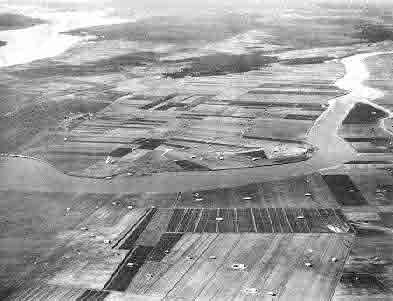 |
| Aerial photo of Koukkoniemi penninsula (Left side- Suvanto-jarvi, right side - Ladoga lake) |
After two days of slow advance Soviet troops covered distance of 20 km. After short skirmish they took Metsapirtti, the last relatively big Finnish settlement on those way to Taipale. And at last, December 6th, first Sovied units advansed to Taipaleenjoki. They came from the south-west, moving toward Neosaari village located just across Terenttila. From this moment there started three-months' period of bloody fighting...
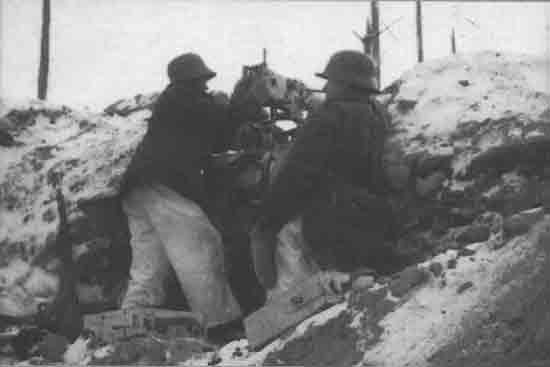 |
| Finnish Maxim machine gun position at Taipale (Photo: "SA-kuva") |
December 16th. New Russian offensive at Taipale. Total fail.
December 17th. Another Russian attack. Digging holes in slopes of hills, Soviet soldiers suffer from cold. They brought with them bricks from burned Finnish houses to made some kind of stoves, but they could not collect enough firewood because each head's rise was dangerous because of constant action of Finnish snipers. Also, smoke of stove could bring fire of enemy's mortars. They burned out own ammo's gun powder, newspaper and even own skies (if they could have it). The one and only way to heat was fight. And they was rising to attack. That day Russians launched attack against all frontline. Action of Finnish gunners reminded carousel when they turned their guns at different angles to hit advanced Soviet infantry rows at Terenttila and Kirvesmaki. Russians were defeated. In Terenttila Finnish antitank guns hit at least five enemy armour vehicles.
Grendal asked for help. It was clear for him that during the frontal assaults on early December his troops lost about half of their order of battle. Soldiers was deadly tired and confused. Powerful artillery barrages were unsufficient. Based on this conclusion, he decided to drive from the western part of Taipale sector by fresh division. The intension was to cross ice of lake Suvanto in few sectors, make arragements for bridgeheads and then to advance to the rear of Taipale defence line. To realize this task, new, 4th rifle division has arrived. All Soviet divisions located on Taipale front were combined into 13rd Army under command of Vladimir Grendal. X-day was appointed on 25th of December.
December 25th. In early morning fresh Soviet 4th division crossed Suvanto on 8-10 km North-West from Taipale front. First Russian batalions began to dig on bridgeheads of Patoniemi, Volosula and Kelja. The biggest Russian concentration was in Kelja where Russians could bring field guns. As early as 8 AM two Finnish batalions of JR30 launched counterattack in Patoniemi and Volossula. Third batalion of JR29 have blocked Patoniemi bridgehead.
December 26th. Kelja's bridgehead had seriously troubled commanders of 10 division. At 7.30 AM Finns had started another counterattack. Russians tried to reinforce their troops by infantry and artillery but finnish guns from Kaarnajoki made powerfil barrage on all open space of Suvanto lake. Whole ice field was covered by corpses of Soviet soldiers.
December 27th. Finnish troops fighted against Russian bridgehead were feinforced by 6th separate batallion arrived after exacting march. All conscripts of this unit were born on Karelian Isthmus. First Finnish counterattack had failed because of late arrival of field guns. Fighting lasts few hours and soon it turn into hand-to-hand battle. All bridgeheads were whiped out by night only. Soviet troops suffered of heavy casualties. On the ice of Suvanto and its north coast 4th division losts 2000 men while Finnish troops lost 500. Finnish boot was estimated as 140 captured machine guns, 12 antitank guns, 500 automatic rifles and 200 rifles as well as thousands of ammos.
December 29th. After two days of bloody fight, there's lull at Taipale. Some skirmishes and artillery duels took place. In Terenttila Soviet troops had tried to advance along Mustaoja creeck with help of field artillery, firing almost point blank to the concrete machine gun nests. However, at night five Finnish platoons were sended to help. Russians were pushed back again.
1939 has came to its end. Thousands of Russian soldiers lay dead on soil of Karelian Isthmus... Need to say, Taipale sector never havent' been almost qiuet. The short skirmishes, small attacks and counterattacks were here permanently. Russians still could not swarm over the Finnish positions but they started to think hard how to do it. Stalin never put away from initial planning. Unsubmissive Finland should be defeated, no matter that how many people would be sacrificed. At least at Taipale Russian troops could keep push, unlike the surrounded and defeated Soviet divisions in Suomussalmi, Kolaa and Lemetti... Russian resources were still unexhausted...
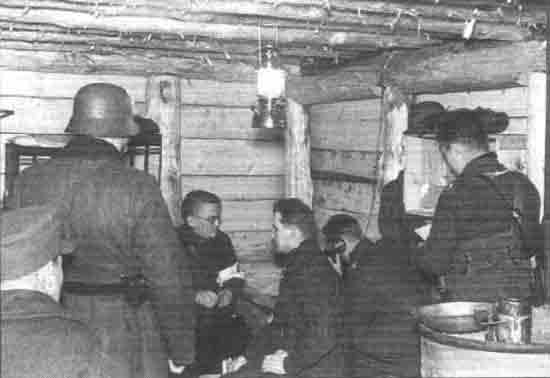 |
| Finnish soldiers sheltered from bombardment preceding the Russian attack on the Mannerheim line in early February 1940.(Photo: SA-kuva) |
February 11th. Soviets managed to take first position of Kirvesmaki just by the shore of Suvantojarvi. During the following night Finnish counter-attack pushed them back.
February 12th. After mortars bombardments, Russians managed to take fifth position of Kirvesmaki. The best part of Finnish defenders were killed and there no way to resist.
February 13th. During furious counterattack Finns took fifth position back.
February 18th. "Black day on Taipale". After two days of lull Red Army launched powerfull offencive. At 9 AM tens of Russian planes bombed Finnish positions for half day. By the evening Russian infantry took all five positions at Kirvesmaki and three western positions at Terenttila. The major part of Finnish machineguns was broken by air attack. Commanders of occupied positions were killed. The experienced batallion of 21 regiment of capt. Sorri was forvarded to stop the Russians. In Terenttila 23rd inf. regiment under command of col. Laurila managed to stop Soviet attack against 4th and 5th positions.
February 19th. Fighting lasts all night and by the morning col. Laurila's batallion took back positions at Terenttila. Russians lost 300 men but right after first attack they rose for another offensive against Terenttila line. Finnish troops had heavy casualties: 1 batallion of 61 regiment under command of Leminen located in Kirvesmaki lost from 260 to 290 dead. Batallion of Larko (1/62 inf. reg.) lost 41 men dead, 57 vounded and 45 lost in action. Same time with the great offencive on land, Russians attempted encircled Taipale position from two direction - from Suvanto (at Patoniemi) and from Ladoga. That attempts were destroyed by Finnish coast artillery. Again, like in December, at Patoniemi alone, ice was blackened by Russian corpses where they leave about 1000 dead and vounded soldiers. At Ladoga Finns managed to destroy two Russian tanks... Besides, Finnish coastal battery on Jariseva, that role for Taipale defense was very important, had fired last shot. The ammunition was over. After that only Kaarnajoki battery still stood for entire Taipale front. Guns of Jariseva were removed but the position was left as false target for enemy's planes...
At this moment Mannerheim had changed commanders of III Army corps. Now it became general-major Paavo Talvela (1897-1973). He had graduated Finnish Military Academy. He had strong will and energy.
February 20th. Day began from powerful air raid of Soviet bombers. After that Russian launched offensive and manage to break all defence line in Terenttila, advanced into the Finnish territory for 1,5 km. Fortunately, Finns could forward division's reserv of maj. von Shroven that could to take back the rear line of defense. From this moment Russian offensive had delayed and soon after that had stopped. The only thing Red Army could do was to continue small attacks by batallion and company's forces.
February 21th. Artillery bunker lokated at Patoniemi got direct hit by 250-mm shell. One men was killed and another six wounded. Above 600 charges were destroyed as well as two guns (indeed, one of them got spare parts and was repaired). At this moment, one of eyewitness, Urho Kahonen, wrote: "The artillery bombardments and air raids of enemy were still powerfull. It affected on us too strong but we could not to counteract of that. Sometimes we even could not to hide because we had to repulse flows of enemy's infantry..."
February 26th. Soviets took two positions of Terenttila but were forced to retreat.
February 29th. The dug-out in Kirvesmaki got three direct hits, entombing 14 men. At this time fighting continued at 5th and 6th positions in Terenttila. Russians managed to capture the part of 5th position. This day was the last for former olympic champion 42-years old Martti Marteli - he was killed in action.
March 1st. Russians managed to break Mannerheim line at Summa. The main battle was there and on their way to Viipuri. Indeed now Taipale sector became secondary. But it does not means that Russians would rely from their attempts to break Finnish defence here. War has to continue! Spring came with the another shock: command dug-out "Seurahuone" got direct hit. 2 officers and 11 ranks were killed, 6 wounded.
March 2nd. Commander of the Soviet troops at Taipale V.Grendal was released. The Corpse commander F.A. Parusinov took command position instead of him.
March 4th. Russians attacked positions of JR23. Finns had heavy casualties but withstood it.
March 6th. Spring has came. Snow and ice began to melt and Finnish position in sector of "Terentillansuo" swamp need to remove. First was the second position which was removed on new place.
March 7th. Finns repulsed attack of Soviet batallion. Even in this "calm" day Finnish troops lost here 10 dead and 35 wounded.
March 8th. Trenches in Terenttila were with water at half. Also, almost all mashine gun positions, dug-outs for soldiers were destroyed by Russian guns, targeting directly from its positions. The best way to stay against fresh Soviet troops was to leave old positions. At 11 PM Finns decided to retreat beyond new defence line. Retirement was made in secret under cover of night so Russians didn't note anything. Few hours later Russians launchen attack but they found nothing. Finnish positions at Terenttila were empty...
March 10th. Soviet troops occupied former Finnish 4th, 5th and 6th positions in Terenttila and launched attack from there. Finns pushed them back. Fortunately, Russian
artillery "helps" to Finns. It opened fire on former Finnish positions where already Russian infantry dug in.
March 13th. During the last five days Russians attempted to break Finnish defence line at few points with no progress. At this day at 6.30 AM Russians opened artillery fire targeting
Terenttila. Hour later Soviet infantry launched attack against 6th position. They knew that at 11 AM war would be over but those "politruks" forced them to use each minute till end of hostilities.
Simultaneously Finnish position in Kirvesmaki were under heavy bombardment. Only at 11 AM fighting At Terenttila and Kirvesmaki had finished. Unusual silence rose above moon lanscape of Taipale.
Next day Finnish troops started to withdraw beyond new border. They left Finnish soil they die for, but still weren't defeated...
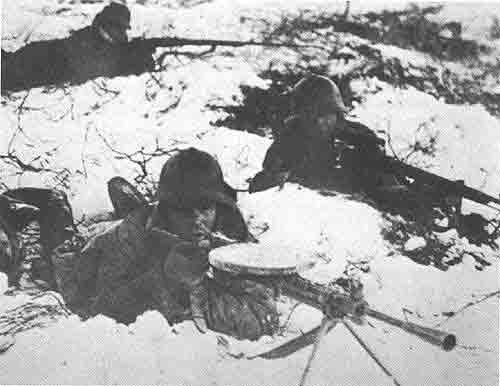
Soviet soldiers are attacking.(Photo: SA-kuva)
During the February-March period Finnish casualties at Taipale were 199 officers and 5442 soldiers. According to the different accounts, Red Army lost here approximately from 2000 to 3000 men. Grendal was dead at autumn 1940, because of lung cancer. Soviets got good lesson. In the time of Continuation war, during the large scale offensive of Summer 1944 their troops just stopped in front of Taipale and didn't attempted to cross it till the end of hostilities...
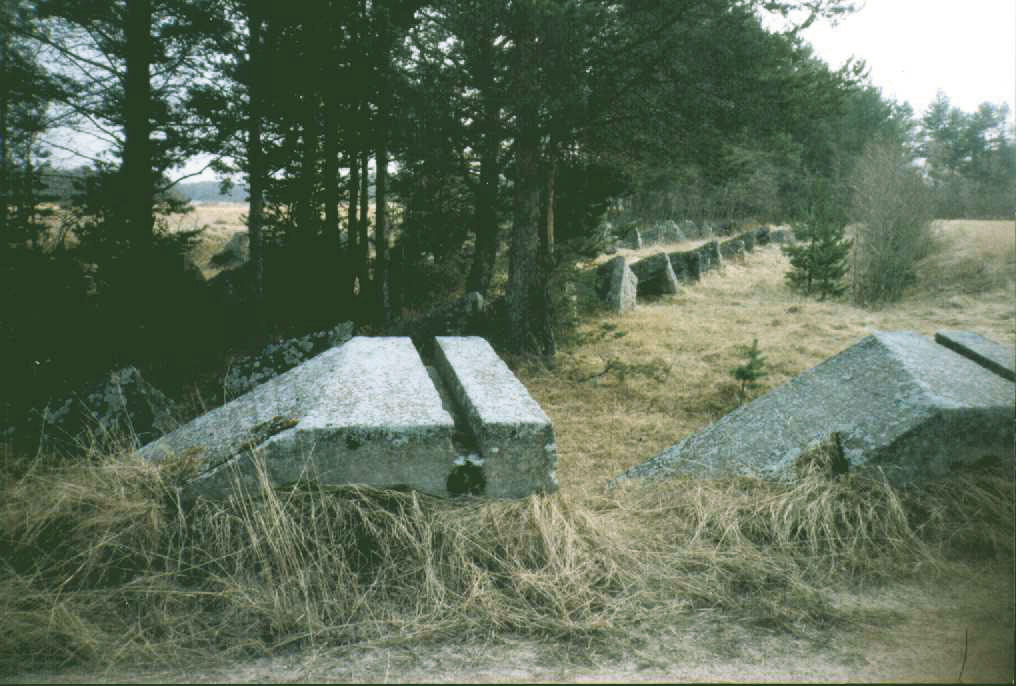 |
| Antitank granite obstacles erected in 1942-1944 (Photo: K. Jakimovich) |
The battle at Taipale was so dense that even now, after almost 60 years, one could see the remains of that. Almost all concrete bunkers were exploited - now only piles of concrete fragments and dence net of trenches reminds about defence line of 1939. During the Continuation war Finns had built here new defence line, "VT" (Vammelsuu-Taipale line). The chain of enourmous antitank granite rocks was erected across entire Taipale sector during 1942-1944. At that time Finns have built here few new concrete bunkers but all those preparation weren't used: Soviet troops managed to break this line in the east part of Karelian Isthmus.
After the war Soviets erected on the former Terenttila territory small monument in memory of fallen soldiers. There are just hundred names has incused on it though thousands of them left here. In 1995 Finnish veterans had erected their own small monument here, iron cross couloured like the birch, on the place where was Finnish military graveyard near the 4th position at Terenttila.
At the place of Terenttila and Kirvesmaki now the farmer's fields. But the whole ground here filled with iron and bones. Occasionally, at spring time, melted water would wash away hand grenade, or machine gun disc, or just human's bone belonged to unknown Finnish or Russian warrior... There were plenty of them here... One could see it and does not feels hate or revenge - just sorrow...
Finnish cross in memory of fallen soldiers erected on the place of former 4th Finnish position at Terenttila
(Photo: K. Jakimovich)Sources:
W. Trotter "A Frozen Hell", Chapel Hill, 1991
U. Kahonen. "Voittamattomat pataljoonat", 1991
"Talvisota. Kronikka", Helsinki, 1997
"Battles in Finland", Moscow, 1941
Periodical literature.
© K.Y. 2001